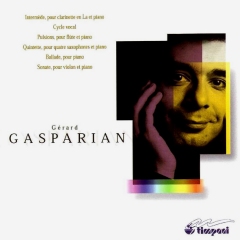CD Timpani - 1C1055 (november 2001) : Chamber Music Works, first worldwide recording :
«Gérard Gasparian is well-known
as a concert pianist, and as a fine exponent of chamber music.
Hence it's not surprising, perhaps, that his music is so rich
in associations and hints of other composers. At the same time,
there is a distinctive voice in the process of emerging, though
he is just 42. Give him time!
The first work on the disc, Intermède for clarinet and
piano, is a good introduction to the lively qualities of his
work, as well as to the high standards of music-making to be heard
here. The piece begins with manic and rather fragmented music,
which gives way from time to time to more easily perceived melodic
and rhythmic shapes. The alternation of wildly energetic music
and more gently flowing passages brings to mind Poulenc, as do
some of the motoric piano textures. But the Poulenc connection
could be misleading, as there is none of that kind of wit or charm.
This is very earnest, rather humourless, music.
This applies to the Song Cycle which follows - settings
of German poetry by Mörike. Kobayashi, ably accompanied by
the composer, sings these difficult songs with great understanding.
The ending of the second, Nimmersatte Liebe (Insatiable
Love) has a striking use of vibrato-less tone, and throughout,
the singer's intonation is unfailingly true and centred, her voice
firm and expressive.
Pulsions for flute and piano, begins with some of the fragmented
type of music heard in the clarinet Intermède. This
is a fascinating piece, with aleatoric episodes in the central
section, and intricate interplay between the two instruments.
For me, the most interesting work on the disc, however, was the
Quintet for 4 saxophones and piano of 1997. The saxophone
repertoire has been steadily widening and deepening over the past
fifty years, and there are now many fine examples not only of
solo works, but also of those bringing together the different
members of this big family of instruments. The way Gasparian combines
the four saxes with the piano is imaginative and resourceful,
in that he certainly doesn't look upon the latter as a mere accompanying
instrument. In fact it doesn't appear until the second movement,
the strangely mechanical Canon, fanfares, which, for me,
brought to mind Ligeti at the outset. Throughout, there are delicious
textures, and strong contrast and changes of mood. Though staggeringly
difficult to bring off, this work is given a superbly confident
performance by the Ledieu Quartet, including their heavy breathing
at the very end!
This fine issue is completed by the splendid piano Ballade,
and the Violin Sonata. Recording quality is very good,
apart from one strange moment of distortion in the Song Cycle.
If you haven't encountered this interesting and talented young
French composer, this disc makes an excellent entrée»
Gwyn Parry Jones - LudwigVanWeb
, 2002
![]()
Pulsions for flute and piano, an homage
to Donatoni, develops other approaches including even random ones;
its "concentric" writing is well constructed. The Quintet
seems to me the major piece on this record, an almost pleasant
and playful example of the influence of electroacoustic music
and of serialism... The performers support perfectly well this
sincere music, that shows an undisputable craft. »
Stéphane Friederich, 5/5 Classica - May 2002
![]()
« His Intermezzo for clarinet and
piano, opening this first monographic recording, reflects the
lively and consonant character of his music, guided by the popular
musics rhythms. This colourful writing can still be found
in Pulsions, five years later, in the skilful contrast
that shapes the singing flute of Emmanuelle Ophèle and
the jolting piano of Hideki Nagano. A ductile serialism guides
the exuberant conversation of a saxophone quartet and a piano,
in the concise and elegant forms of the Quintet...»
Franck Mallet, Le Monde de la Musique (3***) - April
2003
![]()
«The composer lives in a borderless territory,
and he occupies, depending on the works, this region or another...
he remains himself, adopting, along his way, a variety of languages
that seldom can be found written by the same pen. »
Jacques Bonnaure, La
Lettre du Musicien - January 2002
![]()
«His Ballad for piano (1988), with
its somewhat post-romantic climate, is - according to our taste
- one of the most genuinely felt. It successfully unites the memory
of a "Rachmaninovian" orientalism with a clearly more
contemporary pianistic form. His Vocal Cycle based on poems
of Mörike is very appealing too, with its reminiscences
of serialism. The whole record is performed with much conviction
by soloists to whom these pieces are often dedicated. The parts
of piano - the omnipresent instrument - benefit from the presence
of the composer himself, an obvious virtuoso, and this enriches
its use, even as an instrument of accompaniment.»
Alfred Caron, Ecouter voir - April 2002
![]()
«Gérard Gasparian vividly shelves
as a rearguard combat the conflict that has been fought until
then in the matter of contemporary music, opponing a hermetic,
scholarly, experimental music, often the heir to all the vanguard
languages that went over the twentieth century, to easier and
willingly lyrical modes of expression, and so more accessible
to a larger music loving general public. Taking the opposite view
of this dispute, he succeeds in this exploit not to yield neither
to academism nor to modernity, and achieves an original work,
that "melodiously" reconciles the two rival schools.»
Raphaël Bagdassarian, France Arménie - December
2001
![]()
« An astonishing first CD recording...
He plays with sounds as we do with light: he casts and diffracts
the musical themes into a multiplicity of small sonic cells: dramatic
falls, jolts, curls and whirls in which piano is used as
a percussion instrument. G. Gasparian so escapes the temptation
of the ever-newness as well as of the comfort of academism,
and he doesn't deprive himself, as he goes past, of some
romantic accents. »
Nouvelles d'Arménie - December 2001
![]()
![]()
CD Pierre Vérany - PV796111 (1996) : «Dedications » for saxophone and piano, by the Portejoie-Lagarde Duo
«A fully spirited music, teasing and winking,
with its kindly joking jazzy tones. Some stylistic inventions&
that wittily make us feel in high spirits.»
Le Progrès - December 1996
![]()
«The Intermezzo for saxophone and
piano of Gérard Gasparian, a keen and striking energy...»
<La Provence - September 1999
![]()
«The Intermezzo, a vibrating piece,
whose hasty, breathless rhythms break into nice lyrical episodes.
»
Sud-Ouest - April 2000

